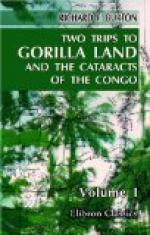Little need be said about our return, which was merrier than the outward bound trip. Wind, tide, and current were now in our favour, and we followed the chords, not the arcs, of the several bays. At 9.30 P.M. we gave a wide berth to the rollers off Point Nyonye and two hours afterwards we groped through the outer darkness into Bwamange, where the good Azizeh and Asunye, who came to receive us, shouted with joy. On the next day another “gorilla palaver,” when a large male was reported to have been shot without a shadow of truth, detained me: it was the last straw which broke the patient camel’s back. After “dashing” to old King Langobomo one cloth, one bottle of absinthe, two heads of tobacco, and a clay pipe, we set out betimes for the fifteen miles’ walk to Mbata. Various obstacles delayed us on the way, and the shades of evening began to close in rapidly; night already reigned over the forest. Progress under such circumstances requires the greatest care; as in the streets of Damascus, one must ever look fixedly at the ground, under penalty of a shaking stumble over cross-bars of roots, or fallen branches hidden by grass and mud. And the worst of these wet walks is that, sooner or later, they bring on swollen feet, which the least scratch causes to ulcerate, and which may lame the traveller for weeks. They are often caused by walking and sitting in wet shoes and stockings; it is so troublesome to pull off and pull on again after wading and fording, repeated during every few hundred yards, that most men tramp through the brooks and suffer in consequence. Constant care of the feet is necessary in African travel, and the ease with which they are hurt—sluggish circulation, poor food and insufficient stimulants being the causes—is one of its deplaisirs. The people wash and anoint these wounds with palm oil: a hot bath, with pepper-water, if there be no rum, gives more relief, and caustic must sometimes be used.
We reached Mbata at 6.15 P.M., and all agreed that two hours of such forest-walking do more damage than five days along the sands.
Since my departure from the coast, French naval officers, travellers and traders, have not been idle. The Marquis de Compiegne, who returned to France in 1874, suffering from ulcerated legs, had travelled up the Fernao Vaz, and its tributary the highly irregular Ogobai, Ogowai, or Ogowe (Ogobe); yet, curious to remark, all his discoveries arc omitted by Herr Kiepert. His furthest point was 213 kilometres east of “San Quita” (Sankwita), a village sixty-one kilometres north (??) of Pointe Fetiche, near Cape Lopez; but wars and receding waters prevented his reaching the confluence where the Ivindo fork enters the north bank of the Ogobe. He made observations amongst the “Kamma” tribe, which differs from the Bakele and other neighbours. M. Guirold, commanding a cruiser, was also sent to the estuary of the Rembo or Fernao Vaz, into which the Mpungule (N’poulounay of M. du Chaillu?), ascended only by M. Aymes, discharges. The explorers found many shoals and shifting sands before entering the estuary; in the evening they stopped at the Ogobe confluence, where a French seaman was employed in custom-house duties. M. de Compiegne, after attending many palavers, was duly upset when returning to the ship.




